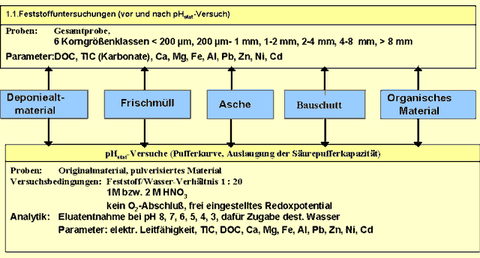Doctoral thesis Helga Grischek
Studies on the buffering behavior of waste components in municipal solid waste landfills
by Helga Grischek
Period: 1998 - 2000
Concept of the work:
Inducement
The acid neutralization capacity (SNK) and buffering kinetics of residues from waste incineration or hazardous waste landfills is very well investigated because of the high pollutant contents (especially heavy metals). This is not the case for municipal waste landfills.
It is assumed that the input of acid rainwater in a time frame of several millennia cannot lead to acidic conditions in a landfill. In the case of a flooded landfill (residual open pit, acidic groundwater with pH 3-5) with orders of magnitude greater flow through the landfill, it is not certain that the pH environment will remain so neutral over the long term. The release of heavy metals from a flooded landfill would affect the use of the residual open pit lake as a bathing or fishing water.
Hypothesis
The acid neutralization capacity (SNK) of a municipal solid waste landfill flowed by acidic groundwater (pH 3-5) may be depleted over the long term. The released heavy metals may lead to an impairment of the use of the open pit lake.
Target
- To describe and quantify the SNK of a municipal solid waste landfill.
- Buffer effectiveness of the waste components
- Statements on the development of the SNK during the lifetime of a landfill (e.g. carbonation, humification, influence of redox ratios)
- Estimation of whether or in which time periods the SNK of a flooded landfill can be exhausted
Experimental concept "Determination of the acid buffer capacity of waste and waste components".
Hypothesis: A landfill flooded with acidic groundwater can achieve an acidic pH environment in the long term.
Diplome theses in the context of the dissertation:
- "Groundwater modeling in the area of a flooded landfill", Uli Uhlig, 2000,
- "Investigations on the acid buffer capacity of flooded landfills in opencast mining areas with special consideration of the main buffer substance ash", Gerit Rotschky, 2000.

